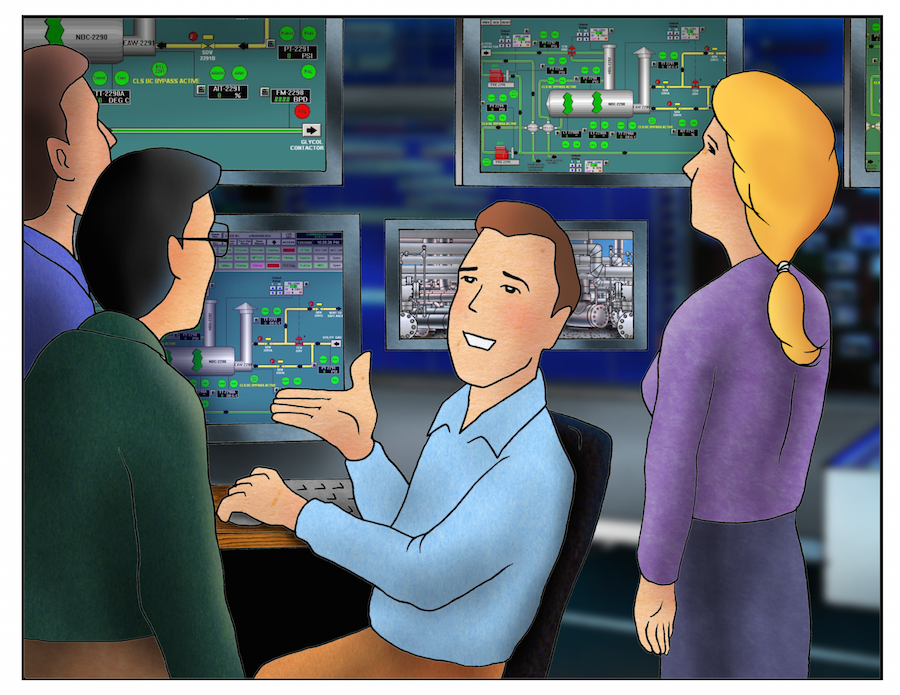How does teamwork take place in your control room? Does teamwork take place in your control room? Controllers are assigned individual responsibilities for a console in most control rooms and have both the authority and accountability for the actions taken at that console. It is every man or woman for himself or herself, isn’t it? Of course, it is not or it should not be that way. I have devoted the last 30 years of my life teaching and preaching the virtues of people working together to accomplish common goals and worthwhile purposes. In some cases, I failed. A few times, I succeeded.
What does it take to accomplish teamwork in a control room where some of the people are there on day shift, others are there on night shift, and those who work rotating shifts are off duty about half the time. I believe the starting point is to have a common definition. I like this one from The Wisdom of Teams: A team is a small number of people with complementary skills who are committed to a common purpose, performance goals, and approach for which they hold themselves mutually accountable. It is important to have a common purpose that is meaningful to all, and that is aspirational, if not inspiring. What is the common purpose of your team? Does everyone on the team know the performance goals and the approach to work they will use to meet the goals and to accomplish the common purpose?
This gets complicated when making plans for meeting the PHMSA proposed rule language that will require companies to provide: (6) Control room team training that includes both controllers and other individuals who would reasonably be expected to interact with controllers (control room personnel) during normal, abnormal or emergency situations.
If a team is a small number of people with complementary skills, what other individuals interact with controllers? Control Room managers and supervisors, technical support, SCADA personnel, and field personnel interact with controllers on a regular basis.
It is relatively easy to provide control room team training if a company gets the right people together for a session. We can conduct a course in about eight hours, have everyone sign the attendance sheet, and check the box that control room team training has been completed. I hope companies will take a more serious, disciplined approach to teamwork in control rooms. The rest of this article will provide a template for that type of approach. The template is based on previous projects we have done with leadership teams, operations teams, and control room teams. There is nothing magical about building a team. It takes a practical approach, regular and ongoing communication, attention to behaviors, accountability for results, and hard work.
- Define and develop the common purpose of the team with all those who work in the control room and with those who support and interact with the controllers. It should be linked to the purpose of your company and its operations. Most companies have some type of mission or vision that is communicated throughout the organization and to the public. Think about the mission of PHMSA: Our mission is to protect people and the environment by advancing the safe transportation of energy and other hazardous materials that are essential to our daily lives. It should be possible for control room teams to link to that mission. The common purpose should include a focus on pipeline safety and public safety, in addition to business goals. The purpose should emphasize outcomes that the members of the team influence.
- State the guiding principles that link the control room team to a larger purpose and to the larger organization and to regulatory agencies. Your company probably has values and philosophies for safety and operations. For example, I used this search term “pipeline company values” and found the company values below that might be applicable to control rooms. The control room team guiding principles should be based on your company’s values, if your company has stated values. If it does not, it should be easy to develop ones that emphasize what is important in control rooms.
| Company One | Company Two | Company Three |
| Honesty and integrity | Community | Integrity |
| Teamwork | Integrity | Collaboration |
| Pursuit of excellence | Safety | Responsibility |
| Personal accountability | Environmental stewardship | Innovation |
| Entrepreneurial spirit | Economic sustainability |
- The next step is to state the objectives of the control room team. Here are some ideas:
- Ensure the goals and directions of the control room team are aligned with the corporate strategies, goals, and shared initiatives. (This requires knowing what those strategies, goals, and initiatives are.)
- Ensure the creation and application of policies, processes, procedures, and practices for the control room team that lead to professionalism.
- Ensure the operational integrity and safe performance of the pipelines and systems in your trust and care.
- Focus on the development of people to ensure the control room team is properly trained, competent, and qualified. Always be teaching and learning.
- Focus on customer satisfaction for internal and external customers.
- Have a positive effect on one another and others with whom you interact.
- Value the diversity and experiences of team members, appreciating different perspectives of coworkers and customers.
- Display the spirit and attitude of the control room team at all times.
- Then clearly define team responsibilities and accountabilities.
- Work well as a team.
- Maximize strengths and minimize weaknesses.
- Own issues and problems from identification to resolution.
- Collaborate with other members of the team.
- Set priorities and action plans; meet due dates.
- Manage company resources well (your time, your equipment, your storage areas, your control room, your budget).
- Practice effective communication with one another and rest of team.
- Implement the changes related to major projects by the due date.
- Develop and implement team norms and behaviors. These might fit your team:
- Listen with your full attention.
- Look for the good in others.
- Don’t talk about one another; talk with one another.
- Have a sense of humor.
- Say “thank you” for a job well done.
- Focus discussions so that they remain productive and valuable.
- Remain punctual for guests and respectful of their time.
- Act in a non–intimidating manner to others.
- Have a follow up action plan for agenda items.
- Display the spirit and attitude of leaders at all times to others in the control room and others who interact with you.
- Check our performance compared to the norms with guests after any job and with one another at the end of jobs, discussions, and meetings.
- Ask for and provide constructive feedback.
- Provide both positive feedback and feedback for improvement.
One of the reasons for the proposed rule requirement is that controllers and control rooms are not independent. They are dependent on information from SCADA and from other people in order to do their jobs. There are interdependencies with field personnel, SCADA personnel, and others in order to ensure correct operations. Build a control room team using the information in this month’s article. That is one way to improve performance.
“Groups always have some norms, even if they’re not written down.” – Charles Alday




